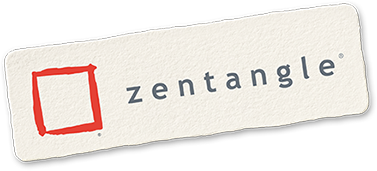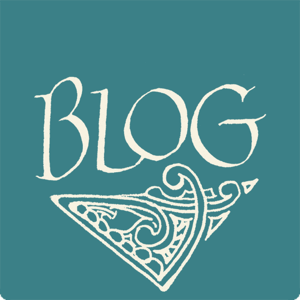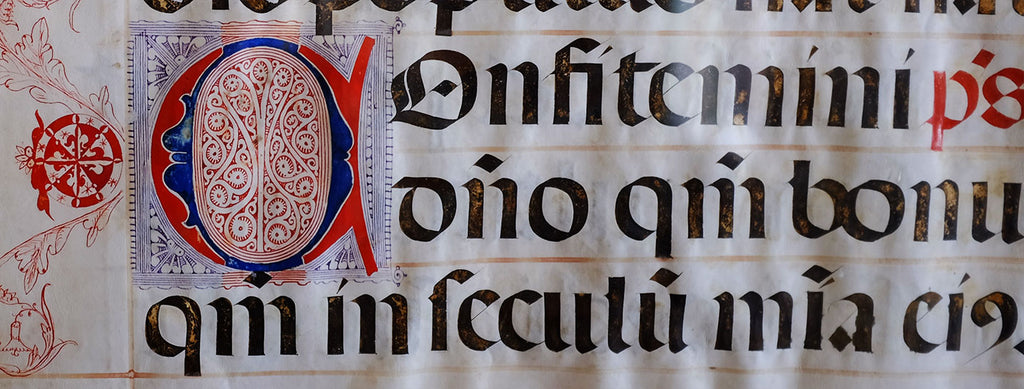Rick writes:
I came across these gems while sorting through files of old pictures.

About eight years ago, Maria and I were in western Massachusetts. These beautiful manuscripts were in a restaurant where we enjoyed a lovely dinner. I took these pictures with the intent to share them with you. Well, better late than never. (Or, maybe I already did and we all get to enjoy them again!)
I estimate that these manuscripts are from the 17th or 18th century. They are all hand-lettered on vellum, probably a sheepskin or a goatskin.
The pen strokes were beautiful, so fresh and crisp, you wonder if the ink was still wet. But take a look at the tangles embellishing the initial capital letters.

Here's a closer look . . .

Check out those aura lines holding delicious fragments . . . and that gently crenelated outer aura. What a hand!
And in this next close-up . . .

More auras surrounding some flux (or is it mooka?) with some tiny orbs in the interstices. And what is that in the middle of the Q? I haven't seen that before. That has great potential for a new border tangle.
Check out the background in that angled pattern. It's not a solid color. It's a tight cross-hatching. What care and affection went into this creation! Perhaps in some dimension, the scribes' hearts are basking in the appreciation of thousands of readers admiring these precious jewels.
Here's a beautiful large illuminated C with marginalia:

I love that positive/negative medallion in the margin with the vinings echoing sampson or is that icanthis? Look at that wonderful adaptation of hollis inside the letter. What a great idea to use hollis to totally fill a section as it curves and grows within itself.
When I interrupted Maria that quiet Saturday back in 2003, she was embellishing a gilded letter with simple patterns in the spirit of these manuscripts. If you've heard our story, that was the seed inspiration for this grand Zentangle adventure. I think that is one reason we were so drawn to these manuscripts.
Here are a couple more examples of some of the smaller initial caps using mooka, hollis, and, of course, lots of auraing.

Here's one more . . .

Notice the triangular fragment to the right of the "S." It looks like fragment F12 in Zentangle Primer Vol 1. What's old is new again. Or, what's new is old again!
See how the artist uses aura in the above three letters to create a slight space between the interior tangle and the letter. That is a familiar technique in Zentangle compositions when a tangle is next to another shape.
And here is the other large capital with marginalia:

The delicate hollis in the margin balances the more structured hollis inside the Q.
In this last close-up we focus on that intertwining cable-like pattern:

I've started playing with different ways to deconstruct it to create a step-out. I think it might be enjoyable to tangle.
This can be a fun exercise for you to explore deconstruction.
Deconstruct ( dē′ • kən • strŭkt′ ) - To reduce a pattern to its elemental strokes so that a user of the Zentangle Method can recreate it as a tangle, by repeating those strokes one at a time in a simple, structured sequence.
(This may already be a tangle out in the Zentangle universe. If it is, let me know. But even if it is, you might try creating your own step-out first.)
Update March 2024: You can view the follow up to this blog here.
Enjoy,
Rick
P.S.
If you're new to the Zentangle blog, the words in italic are names of patterns that we call tangles. A good way to see what tangles look like is to download the Zentangle Mosaic app. It works on iOS and Android. You can search the contents for free. You can subscribe if you want to post and comment.
R
--- + ---
Thank you to everyone who submitted their mnemonic device for ICSO! It was so much fun to read through each and every one.
Bijou has selected Ulrike’s submission Inspired Chaos, Subtly Organized as his favorite! Please send your snail mail address to info@zentangle.com
The commenter randomly selected to also receive a Zentangle surprise is Kathleen McMurty (I Create Something Original). Please send your snail mail address to info@zentangle.com as well!
There were so many wonderful ideas, Bijou also selected some zenorable mentions:
I Can Show off
- Janice Stefane
I Can Save Optimism
- Marina Dali
In Chaos Silence Occurs
- Yvonne Li
In Constant Search Of
- Lori Riden
Images Can Surprise Others
- Judy Grimes
I Can Smile Often
- Jill Maxwell
I Can See Options
- Sally Houghton
Interesting Conundrums = Satisfying Outcomes
- Bee Raine
Intertwined Strokes Create Opportunities
- Katrina Thiebaut
Celebration of Intentional Strokes
- Anne Ott
In Calmness Sense Opportunity
- Catherine Gisby



The intertwining cable like pattern has been deconstructed by Maria Vennekens. She has called it Otto snd it’s on musterquelle.de
Wonderful finds on these manuscripts. They were tanglers, they just didn’t know it back then! 🤣
Debbie Raaen on
Mary Ellen Ziegler CZT33 on
Wow! This brings the familiar into a centuries old new focus. As always, I’m seeing wonderful organic and architectural patterns everywhere since my eyes have been opened to Zentangle and this reminds me to look and appreciate the smallest details in everything.
Linda Elkin on
Linda Hunter, CZT 31 on
Helen on
Shelley Miller on
Rimona Gale on
is what my HS art teacher always said. I’ve been a calligrapher since HS art class 60 yrs ago. The Book of Kells and the Gospels of Lindisfarne, as well as Islamic, Hebrew, and other historic “Illuminated” manuscripts, were used as examples in HS art classes, not to mention the Speedball Handbook and other graphic arts manuals. Subsequent calligraphy instructors Steven and Sharon Schwartz, (Ohio) taught ornamental patterns and illuminated decoration of our calligraphy pieces using “fragments and reticula” and also taught us deconstruction techniques for many of the Celtic patterns, borders, etc. Maria’s exquisite calligraphy, is what drew me to the Zentangle art form, after seeing your lecture at the NMAI in Newport, RI, in the Summer of 2018. I immediately signed up for a Zentangle class at my local senior center back in CT. The CZT thought I had studied Zentangle before because it came so easily to me. I told her no, it came from my calligraphy background, as well as my HS and college art history classes. Thanks for sharing the “origins” story again. Love your beautiful images of the “inspirational” manuscripts that started it all. I learn a lot from all your trips down memory lane…please keep ’em coming for those of us who were not here when you first started your journey!
Jessica Dykes (aka, Jake) on
Dianne Riva Cambrin on
Francene l. Smith on
CeCe Bushinsky on
Ginger White CZT34 on
This blog was a lovely way to start my day. When I went to CZT training in 2018 we had a wonderful docent led tour of the downtown and RISD which opened my eyes to seeing the patterns/Zentangles everywhere in the environment. I credit this and Zentangle with the initial flowering of my artist self. Thank you for all you (collectively and individually) bring to our world.
Deb Murray CZT30 on
Elaine Novak on
Such a great blog and wonderful photos that are very engaging :) I love seeing tangles “out in the wild” and spend lots of time photographing and deconstructing patterns I also come across. I joke I am a deconstruction worker :)
That tangle was published in The Great Zentangle® Book under the name SWEDA, by Maria Vennekens (p. 98). I just used it in a tile last week which is why I could pull this out of my head hahaha
Jenn Brayton CZT36 on
Chrissie Frampton on
PamS on
Holy cow! What a find!
Kathy Y. on
Karen K Keefe on